Click Here To Join Our Telegram Channel for FREE daily tutorials!
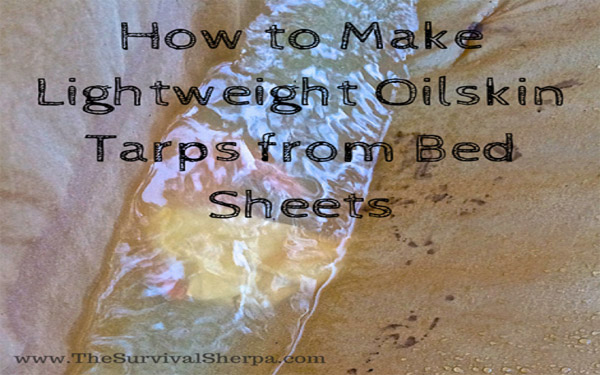
Weight – a unit of heaviness or mass; any heavy load, mass, or object; the vertical force experienced by a mass as a result of gravitation.
Gravity. It’s inescapable… on this planet. It keeps us grounded. But it also weighs us down.
I consider myself to be in decent physical condition. Even so, at my age, every pound added to my backpack affects the gravitational pull and energy needed to carry the stuff. I’m no ultralight hiker by any stretch, but I do try to lighten my load every chance I get.
I’ve wanted to own an oilskin tarp for some time now. They’re durable but too pricey for our budget at this time. A quality oilskin tarp (new) will set you back $200. My motto, when it comes to gear, is buy the best you can afford. Or, go the common man route and make your own.
The idea for this project came from William Collins’ 4 part series on his YouTube channel. I’ve condensed his method into a short tutorial for you.
Stuff You’ll Need
• 100% Egyptian cotton bed sheet (flat). The higher the tread count the better. I used a king size which measures 8.5′ x 9′.
• 20 oil lamp wicks (1/2″ x 6″). They come in packs of 5 at Wally World.
• Boiled linseed oil – 3 to 4 cups (depending on the size of your cloth)
• Mineral spirits – 3 to 4 cups
• Dye (optional) unless your sheet is the color you desire
• Containers
• Heat source
• Rubber gloves
Prep the sheet: Before the dyeing process begins, wash the sheet in cold water and washing powder. Then dry on high heat to close and tighten the woven fibers in the sheet.
Sew the lamp wicks on all corners and at two-foot intervals along the edges. I sewed these on by hand. A sewing machine would take less time but that’s how I roll. I added 3 additional loops down the center of the sheet to allow for more options when configuring my tarp.
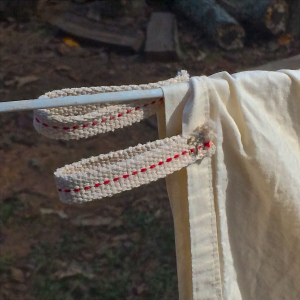
Step 1: Making Natural Dye
I filled the bottom of a 10-inch pot with green hickory nuts from a tree in our yard. Thank you, squirrels! Use an old pot that you don’t mind staining. I then added several black walnuts (green hulled) to the mix which happen to be dropping from trees now.
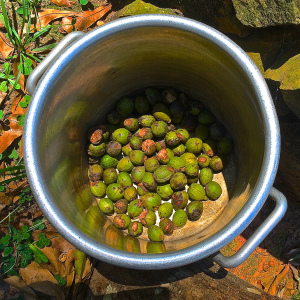

With the dyeing agent (green nuts) in the pot, fill 3/4 full with water. Bring to a boil on an outdoor fire. Allow to slow boil for an hour or more. The longer you boil, the darker your dye will become. I was going for an earth tone.
You can also break the green hulls off the black walnuts to increase the surface area and improve the extraction process. Be aware that the hulls will stain anything they touch – skin included.
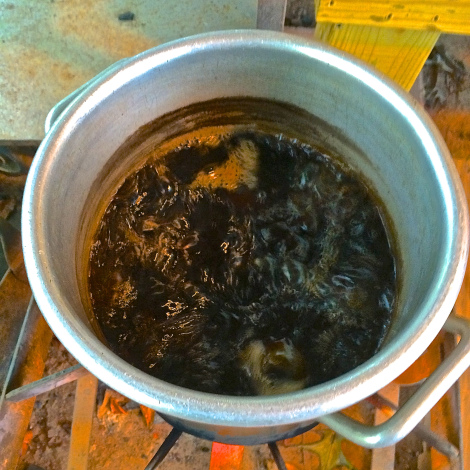
If you choose not to make your own natural dye, RIT dye is available at most grocery stores.
Step 2: Dye the Sheet
Test the color of your dye on a piece of scrap cloth. If you’re satisfied, strain the dye mixture into a clean container. A window screen over a bucket works well.
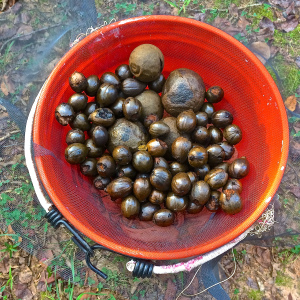
Place the sheet into the container. Use rubber gloves to prevent staining your hands. Turn and squeeze the material for a thorough coverage.
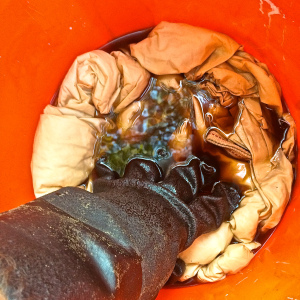
Leave the sheet in the dye for 24 hours. Longer for a darker color. To keep the sheet submerged, I place the lid of cast iron dutch oven on top. Not recommended. The greasy drip spikes on the lid left a polka dot stain pattern on the bed sheet. What was I thinking!? I replaced the heavy lid with one of DRG’s small dinner plates and a 25 lb. dumbbell.
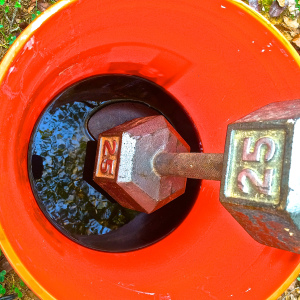
Step 3: Set the Dye
Wring the sheet over the container to remove the excess dye. I hung mine over double clothesline out back to dry.
Once dry, wash it in cold water with washing powder when your wife isn’t home. No, it won’t stain the washing machine tub. The cold water sets the dye. Dry the sheet on high in preparation for the waterproofing.
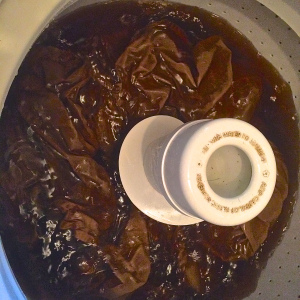
Step 4: Waterproofing
Mix equal parts boiled linseed oil and mineral spirits (drying agent) in a container. I used a 5-gallon bucket. You only need enough to completely saturate the cloth. I used two cups of each and found dry spots on the sheet. Another cup of each did the trick. Other DiY’ers have “painted” the oil on their cloth. For the best coverage, massage the oil into the material in a bucket. You’ll probably want gloves for this step.
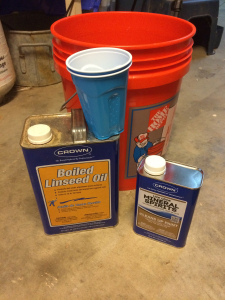
Squeeze the excess mixture from the sheet back into the bucket. Funnel the extra waterproofing liquid in a smaller container and label it for later projects. I used the empty mineral spirits can.
Note on boiled linseed oil: Properly dispose of any oil-soaked rags used to wipe spills. As the linseed oil dries, it creates heat and can combust spontaneously.
Worried about burning down your shop or barn while the tarp hangs to dry? Don’t be. Spreading the tarp to dry dissipates the heat.
Step 5: Cure the Sheet
Hang the oiled sheet vertically under a covered roof outside. In a hurry, I laid my sheet over the double clothesline. This method created two lines down the middle section of the sheet. Plus, it rained that evening. Dumb move. The next morning, water was standing on the sheet between the two lines. I hung the sheet under my attached shed behind my shop the next day.
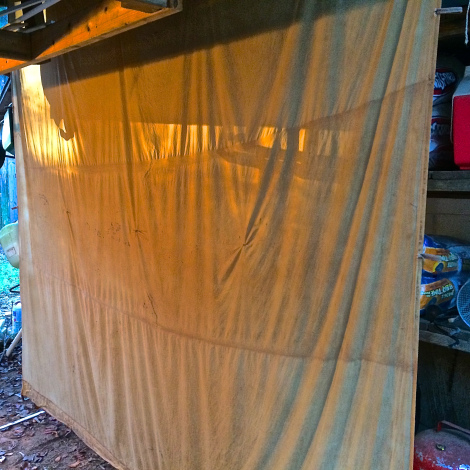
The drying time on the oiled sheet depends on humidity. Well, it rained for three days after I applied the oil. You guessed it, the tarp stayed tacky. When the weather cleared, it dried in 48 hours.
Now for the moment of truth… is it waterproof?
I hung the dried tarp on the clothesline and unreeled the garden hose. I set the nozzle on “shower” and pulled the trigger. This was my common rain shower test. It passed! No moisture behind the tarp when wiped with a paper towel.
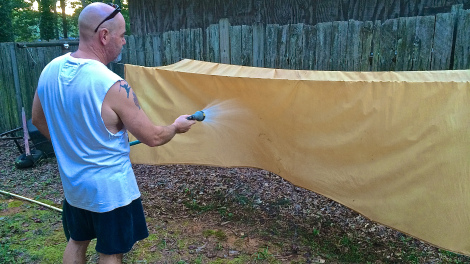
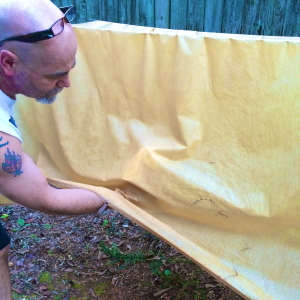
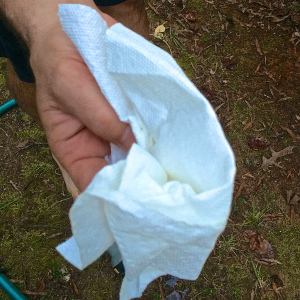
Now for the hurricane test. I set the hose to “jet” from three feet away and blasted the tarp. The paper towel underneath remained bone dry!
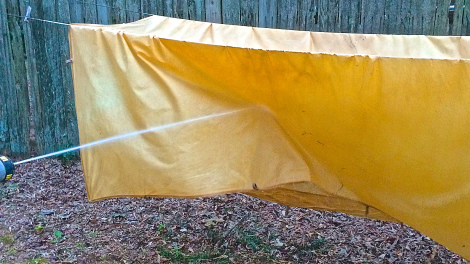
Even with standing water between the clothesline, no drips or moisture anywhere. Good to know the tarp could be used to harvest water in a survival scenario!
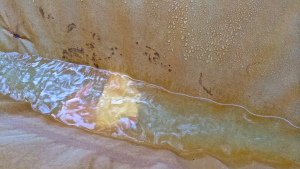
As far as durability, I’m pretty sure my bed sheet tarp won’t outlast an eight-ounce canvas oilskin tarps. Maybe it will. Time will tell. I’m testing it this weekend at the Pathfinder School Basic Class. I’ll update y’all on its performance.
Keep Doing the Stuff of Self-Reliance,
By Todd Walker
This Crazy Off Grid Device Literally Makes Drinkable Water From Fresh Air:
According to NASA, the U.S. is expecting a 100-YEAR LONG MEGADROUGHT.
It's already begun. Ask the farmers in California. They know.
Every survivalist knows that water is of critical importance. You NEED an independent water source that you can count on!
As an interesting "survival rehearsal" - imagine that you turned the tap on right now and nothing came out. How long would you last?
But what if there was another water source literally hidden in plain sight. That's right, I'm talking about the atmosphere!
The amazing thing about getting water from the natural moisture in the air... is that it is ALWAYS available.
This gives you real water security!
Learn more about how to tap into "Nature's secret water reservoir" and stay hydrated when TSHTF!
Watch the video:
😳 What Tinnitus Does To Your Brain Cells (And How To Stop It)
After 47 years of studies and countless brain scans done on more than 2,400 tinnitus patients, scientists at the MIT Institute found that in a shocking 96% of cases, tinnitus was actually shrinking their brain cells.
As it turns out, tinnitus and brain health are strongly linked.
Even more interesting: The reason why top army officials are not deaf after decades of hearing machine guns, bombs going off and helicopter noises…
Is because they are using something called "the wire method", a simple protocol inspired by a classified surgery on deaf people from the 1950s...

I Can't Help Showing This Off:
If you haven't heard of Claude Davis yet do yourself a huge favor and watch this video.
One of the smartest guys I ever had the pleasure of meeting, Claude set-up a unique prepping system that changed his life forever.
I already tried it myself and let me tell... you I was completely blown away... His surprising tactics could make your life easier and give you the peace of mind you deserve.
Don't just take my word for it... watch his short video and decide for yourself.

Most People Don't Have The Guts To Try This:
An amazing discovery in an abandoned house in Austin, Texas: A lost book of amazing survival knowledge, believed to have been long vanished to history, has been found in a dusty drawer in the house which belonged to a guy named Claude Davis.
Remember... back in those days, there was no electricity... no refrigerators... no law enforcement... and certainly no grocery store or supermarkets... Some of these exceptional skills are hundreds of years of old and they were learned the hard way by the early pioneers.
>> Click here to find out about them now
We've lost to history so much survival knowledge that we've become clueless compared to what our great grandfathers did or built on a daily basis to sustain their families.
Neighbors said that for the last couple of years Claude has tried to unearth and learn the forgotten ways of our great-grandparents and claimed to have found a secret of gargantuan proportions. A secret that he is about to reveal together with 3 old teachings that will change everything you think you know about preparedness:
>>> Click Here To Watch His Short Video <<<

More Off-Grid And Survival Resources:

What REALLY Happens When You Bury a Shipping Container? (Hint: It's A Bit Crazy...)
Shipping containers are all the rage - but if you are thinking about buying one, you MUST watch this video first:
There's a general belief that if you bury a shipping container you can create an awesome root cellar / storm shelter / survival bunker.
But is a shipping container strong enough to handle the pressure?
Watch the video to see what happens:
What Really Happens When You Bury a Shipping Container? (Click To Watch Video)









Great how to article. I do have an idea for you. If you need to make one that is heavier than the bed sheet, try using a painters tarp. They are relatively inexpensive, and available at paint stores. The big box lumber stores may carry them also.
Cool guide!
Any test to see how fire resistant the tarp is???